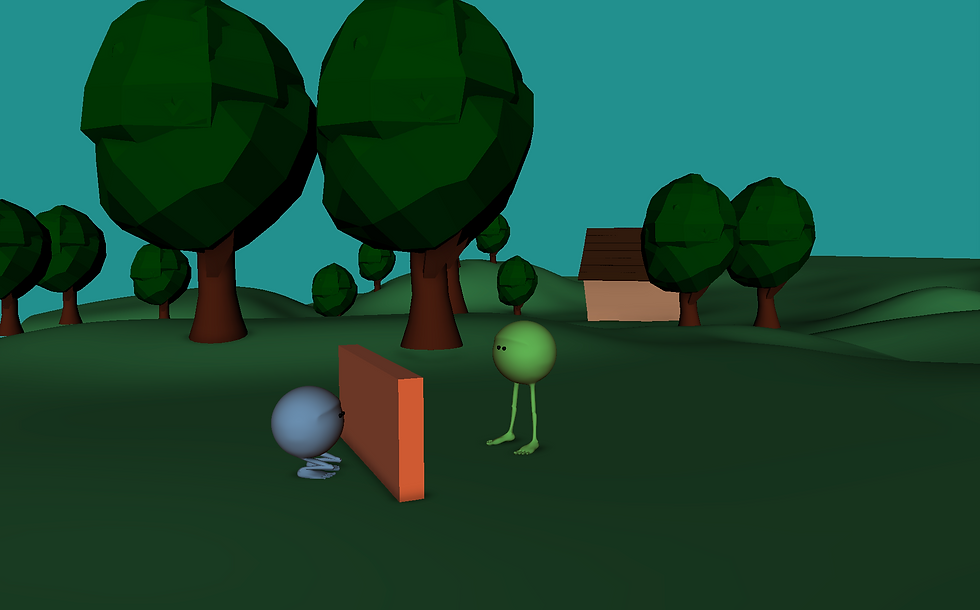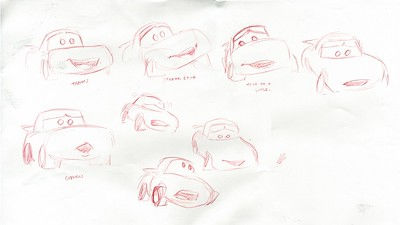Unit 3 : Cartoon biped "Take"
- Briony Davies
- Jun 15
- 3 min read
Updated: Aug 20
In this unit, we learn how to create a reaction shot known as a "take" in the acting industry, where a character has a sudden reaction to an unexpected event that often reveals more about that character. This aids in learning how to create a shot without dialogue while keeping it captivating and emotional. This is crucial to effectively convey a character and their emotions in a shot by amplifying reactions across various emotions, whether angry, happy, or surprised. In this unit, we discover the fundamentals of this principle, as well as incorporating other principles that are essential to animation, such as squash and stretch, timing, and anticipation.

To create this shot, I am using the Monty rig, as suggested in the tutorial, which I found to be a very easy rig to navigate and ideal for this exercise. It was also a challenge to create a reaction shot without a mouth and limited facial features, but if done effectively, it helps improve my skill and ability as an animator. To begin, I broke my shot into five sections (as demonstrated in the tutorials):
Start position
Anticipation pose
Accent/reaction pose
Squash
Settle
I created thumbnails based on these key points, as well as from the tutorial, and focused on the timings to create an effective shot. I thought about this character and what they'd be reacting to, to help add more depth and connection to this shot. With how the character is styled, I almost wanted this shot to seem "silly" or "playful," but with an exaggerated, possibly over-the-top, reaction. I envisioned this scene with two characters: one hiding and then jumping out to frighten the other. The reaction is sudden and surprised, ultimately causing the character to faint. Both characters have very similar animation, but two very different actions and reactions, which I think further enhances the ability to create an effective reaction shot. I also wanted to keep in mind of pantomime in this animation, while not the primary purpose of this exercise, it is the concept we are learning overall in this course. Examining the work of Victor Navone, an American animator, was beneficial due to his profound understanding of capturing body dynamics and personality in his sketches, which is both remarkable and inspiring, in addition to his artistic direction.

I found a cartoon park model on TurboSquid that suited the story's narrative, which I then imported into the scene and resized accordingly. I organised my work by categorising the rigs, background, lighting, and camera, and added them to the animation layers. This way, I could easily turn them on or off, or make them un-selectable to prevent any interaction with the animation.
Aside from the theoretical challenge of crafting a "take" shot, I encountered no technical difficulties, making this exercise relatively easy to complete. I focused mainly on the timing, as even a 1 or 2 frame difference in the character's jump or "scare" before or after the reaction made it seem inauthentic. I also focused on the reaction in the eyes and eyebrows, as they would respond first, followed by the body. Therefore, I offset the body reaction by 1 or 2 frames to create a more authentic response. The anticipation position was crucial to help amplify the reaction. I could have significantly enhanced this position, which would have resulted in a more "slapstick" comedic shot, as well as holding it for a longer duration and then exaggerating the next key pose, the reaction position.
I have discovered and learned animating crucial reaction shots that enhance the emotional connection between the character, the scene, and the audience. This process involves skilfully applying every animation principle, including anticipation, squash and stretch, and timing, along with new principles like the overshoot and settling, which I believe will help as a foundation in creating future animations.
.
Bibliography -
Navone, V. (2018). Victor Navone. [online] Flickr. Available at: https://www.flickr.com/photos/victor_navone/ [Accessed 13 Jun. 2025].
Navone, V. (2018). Cars3. [Online] Flickr. Available at: https://www.flickr.com/photos/victor_navone [Accessed 19 Jun. 2025].


Comments